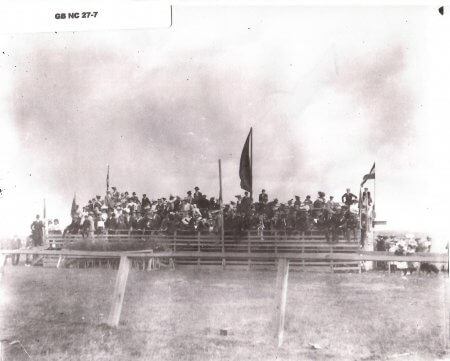The History of Horse Racing in Cochrane
CHAPS is planning monthly presentations of the history of Cochrane and Area. The first, which was given in October, goes hand in hand with an exhibit we’re planning. Thanks to Tim Collard for researching and developing a pamphlet. The presentation was done by Frank Hennessey. Photos courtesy of Glenbow Archives.
Cochrane Races 1900 – 1910 The First Race
The first recorded horse race in Cochrane took place in 1891. W.D. Kerfoot, former manager of the Cochrane Ranche, challenged his brother-in-law, William Bell-Irving, to a match race. Kerfoot’s horse, “The Dude”, won by a nose. This would be
the first of many races won by a Kerfoot horse in Cochrane.
Cochrane Races 1900 – 1910 The First Track
The first Cochrane track was built on land owned by George Bevan, across from the brickyard, between the railroad tracks and the highway.
These early meets largely consisted of local ranchers riding their own horses and racing against their neighbours. By perhaps as early as 1907, however, the popularity of the Cochrane Races drew enough interest from Calgary that the CPR
began to run a special train to bring spectators out to take in the action.
Local Horses, Local Riders
The early 20 th century saw Cochrane establish itself as one of the premier horse raising areas in Western Canada. Anchored by the Bow River Horse Ranch (an offshoot of the Cochrane Ranche) and bolstered by such horsemen as W.D.
Kerfoot, D.P. McDonald, Clem Gardner, The Murphy Brothers, and Walter Hutchinson.
The first thoroughbred in Cochrane was “Konrad”. Imported by Senator Matthew Cochrane, “Konrad” helped to establish the thoroughbred stock in the area. Another import,
“Juryman”, was stood on the Bow River Horse Ranch and sired “Cyclone”, one of the first great horses bred in the Cochrane area. Sold to A.J. Murphy, “Cyclone” dominated the early era of horse racing in Cochrane along with Kerfoot’s “Dixie Land”.
These two horses won races across the continent from Winnipeg to San Francisco.
The Race Industry Grows
By 1910, racing in Cochrane had become the Village’s signature event of the year. The Racing Association decided that a new, modern track, complete with grandstand, was needed. A parcel of land west of town (near the present community of Heartland) was purchased from Robert Howard and the new track was constructed.
Growing Interest
Racing continued to grow in popularity after the new track was constructed in 1910. The Cochrane Advocate referred to the 1910 races as “our great annual holiday” and report that hotel rooms were full throughout the Village as crowds from Calgary flocked in by train and the newly popular motor car.
These races were dominated by horses owned by D.P. McDonald, Clem Gardner , E. Howard Abell and Walter Hutchinson, with McDonald’s “Dolly” winning many of the races held in these years.
Early Race Meets
The Cochrane Racing Association was formed in 1894 by A.J. Murphy, William Bell-Irving and W.D. Kerfoot. In 1895, at the Mitford and Cochrane Races, Kerfoot’s horses won all of the flat races on the program.
Cochrane Races 1914-1931 Outbreak of War
1914 saw the outbreak of World War I and with it, a marked decline in horse racing in Cochrane. The races continued throughout the war, but attendance was significantly lower and the field of both horses and riders diminished as Cochrane
was a major supplier of horses for the Canadian army.
Following the War, racing once again began to grow in Cochrane. In 1922, over 2,000 people attended the Cochrane Race meet. D.P. McDonald and Clem Gardner were still competing and Cochrane Area rancher, Laurie Johnson, won five of the ten races he entered.
The dominance of local ranchers would wain, however, with a change of management at the Racetrack.
Professionalization
Around 1925, the Rhodes Brothers, known locally as “Dusty” and “Bumpy”, took over the management of the Cochrane Racetrack. They modernized Cochrane racing by instituting the newly popular Pari-Mutual betting system and attracting professional horsemen from further afield.
The local ranchers’ race was still included, but the Rhodes brothers capitalized on
Cochrane’s reputation as “the best one-mile turf track in Western Canada” to attract a more serious racing crowd to the annual event. The meet was expanded to become a four-day event with larger prizes for the winners.
Cochrane Races 1914-1931 Famous Jockeys
During the heyday of professional racing in Cochrane in the mid to late 1920s, many aspiring jockeys took to the Cochrane course to ply their trade. Two of those jockeys went on to have hall of fame careers in horse racing.
In May of 1930, a cigar store clerk from Calgary and a young jockey with a penchant for books both made their way to the Cochrane course to compete. In the second
race of the third day, the cigar store salesman, Johnny Longden, beat the bookworm, Red Pollard by a nose.
Red Pollard went on to a hall of fame career as Seabiscuit’s jockey while Johnny Longden won over 6,000 races, making him one of the winningest jockeys of all time.
The End of the Race
The late 1920s looked ready to establish Cochrane as a premier racing venue, but the onset of the Great Depression shattered that hope. The Depression made the large, multi-day races that the Rhodes introduced too expensive an undertaking.
At the same time, interest from the local ranchers had waned as the races became
more professionalized. The last race was held at the Cochrane Racetrack in 1931.
CHAPS Plans Diorama Race Track
CHAPS is sponsoring the construction of a diorama showing the Cochrane Race Track at it’s peak. The diorama will be included in our Tribute to the Horse exhibit Summer 2020.



